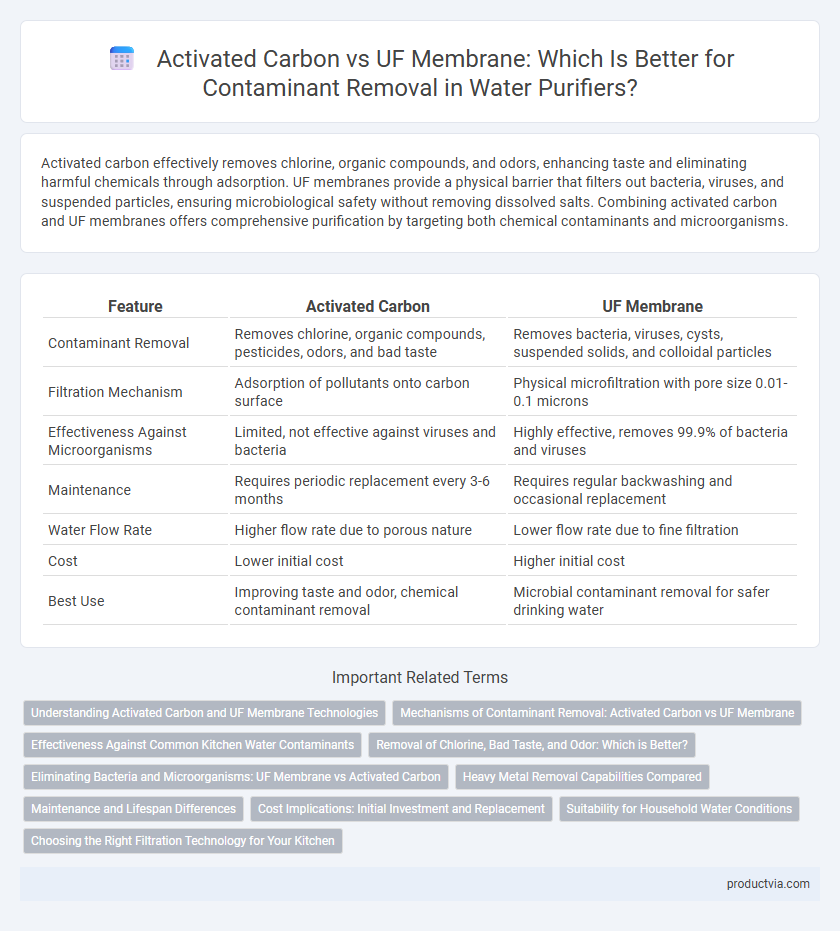Activated carbon effectively removes chlorine, organic compounds, and odors, enhancing taste and eliminating harmful chemicals through adsorption. UF membranes provide a physical barrier that filters out bacteria, viruses, and suspended particles, ensuring microbiological safety without removing dissolved salts. Combining activated carbon and UF membranes offers comprehensive purification by targeting both chemical contaminants and microorganisms.
Table of Comparison
| Feature | Activated Carbon | UF Membrane |
|---|---|---|
| Contaminant Removal | Removes chlorine, organic compounds, pesticides, odors, and bad taste | Removes bacteria, viruses, cysts, suspended solids, and colloidal particles |
| Filtration Mechanism | Adsorption of pollutants onto carbon surface | Physical microfiltration with pore size 0.01-0.1 microns |
| Effectiveness Against Microorganisms | Limited, not effective against viruses and bacteria | Highly effective, removes 99.9% of bacteria and viruses |
| Maintenance | Requires periodic replacement every 3-6 months | Requires regular backwashing and occasional replacement |
| Water Flow Rate | Higher flow rate due to porous nature | Lower flow rate due to fine filtration |
| Cost | Lower initial cost | Higher initial cost |
| Best Use | Improving taste and odor, chemical contaminant removal | Microbial contaminant removal for safer drinking water |
Understanding Activated Carbon and UF Membrane Technologies
Activated carbon effectively removes chlorine, volatile organic compounds (VOCs), and certain pesticides through adsorption, improving taste and odor in water purification. UF membranes use physical filtration with pore sizes typically around 0.01 microns to block bacteria, viruses, and suspended solids, providing a barrier against microbial contaminants. Combining activated carbon with UF membrane technology enhances overall water quality by targeting both chemical impurities and microorganisms.
Mechanisms of Contaminant Removal: Activated Carbon vs UF Membrane
Activated carbon removes contaminants primarily through adsorption, effectively trapping organic compounds, chlorine, and volatile chemicals within its porous structure. UF membranes utilize a physical barrier mechanism, filtering out bacteria, protozoa, and suspended solids by size exclusion with pore sizes typically around 0.01 microns. While activated carbon excels at improving taste and odor by removing chemical pollutants, UF membranes provide superior microbial safety by physically eliminating pathogens from water.
Effectiveness Against Common Kitchen Water Contaminants
Activated carbon filters excel at removing chlorine, volatile organic compounds (VOCs), and bad odors from kitchen water, enhancing taste and safety. UF membranes provide a physical barrier against bacteria, viruses, and suspended particles, ensuring microbial contaminants are effectively eliminated. Combining both technologies delivers comprehensive purification, targeting chemical pollutants and biological hazards common in household water sources.
Removal of Chlorine, Bad Taste, and Odor: Which is Better?
Activated carbon excels at removing chlorine, bad taste, and odors due to its porous structure that adsorbs chemical impurities effectively. UF membranes primarily target suspended solids and microorganisms but are less efficient at eliminating chlorine and odors. For improved taste and odor removal, activated carbon remains the superior choice in water purification systems.
Eliminating Bacteria and Microorganisms: UF Membrane vs Activated Carbon
UF membranes provide superior removal of bacteria and microorganisms due to their fine pore size, typically around 0.01 microns, effectively filtering out pathogens. Activated carbon primarily targets chlorine, odors, and organic compounds but lacks the ability to physically remove bacteria and viruses. For comprehensive microbial contamination control, UF membrane technology is the preferred choice in water purification systems.
Heavy Metal Removal Capabilities Compared
Activated carbon and UF membrane technologies differ significantly in heavy metal removal capabilities; activated carbon excels at adsorbing heavy metals like lead, mercury, and cadmium by trapping them within its porous structure. In contrast, UF membranes primarily rely on physical filtration with pore sizes around 0.01 microns, which effectively removes suspended solids and pathogens but is less effective at filtering dissolved heavy metal ions. Combining activated carbon with UF membranes offers a comprehensive solution for enhanced water purification by leveraging both adsorption and filtration methods for heavy metal removal.
Maintenance and Lifespan Differences
Activated carbon filters require regular replacement every 3 to 6 months due to saturation of adsorptive surfaces, whereas UF membranes last up to 1 to 2 years with proper backwashing and minimal chemical exposure. Maintenance for activated carbon involves frequent cartridge changes to prevent bacterial growth, while UF membranes need periodic cleaning to remove fouling and extend membrane integrity. The longer lifespan and reduced downtime of UF membranes make them more cost-effective for long-term contaminant removal in water purification systems.
Cost Implications: Initial Investment and Replacement
Activated carbon water purifiers generally have a lower initial investment cost compared to UF membrane systems, making them suitable for budget-conscious consumers. Replacement frequency for activated carbon filters varies between 3 to 6 months, contributing to ongoing maintenance expenses, while UF membranes typically require replacement every 1 to 2 years due to their longer lifespan. The total cost of ownership for UF membrane purifiers can be higher upfront but potentially lower over time, given their durability and efficiency in removing a wider range of contaminants.
Suitability for Household Water Conditions
Activated carbon filters effectively remove chlorine, organic compounds, and unpleasant odors commonly found in household water, making them ideal for improving taste and odor. UF membrane technology excels at eliminating bacteria, viruses, and suspended solids without the need for chemicals, suitable for areas with microbiological contamination. Combining both technologies can offer comprehensive purification, adapting to various household water quality challenges.
Choosing the Right Filtration Technology for Your Kitchen
Activated carbon filters excel at removing chlorine, volatile organic compounds (VOCs), and improving taste and odor, making them ideal for enhancing water quality in kitchens. UF (Ultrafiltration) membranes provide superior removal of bacteria, viruses, and suspended particles, ensuring microbiologically safe water without chemicals. Selecting the right filtration technology depends on your local water quality and specific contaminant concerns, with many systems combining both for comprehensive purification.
Activated carbon vs UF membrane for contaminant removal Infographic

 productvia.com
productvia.com